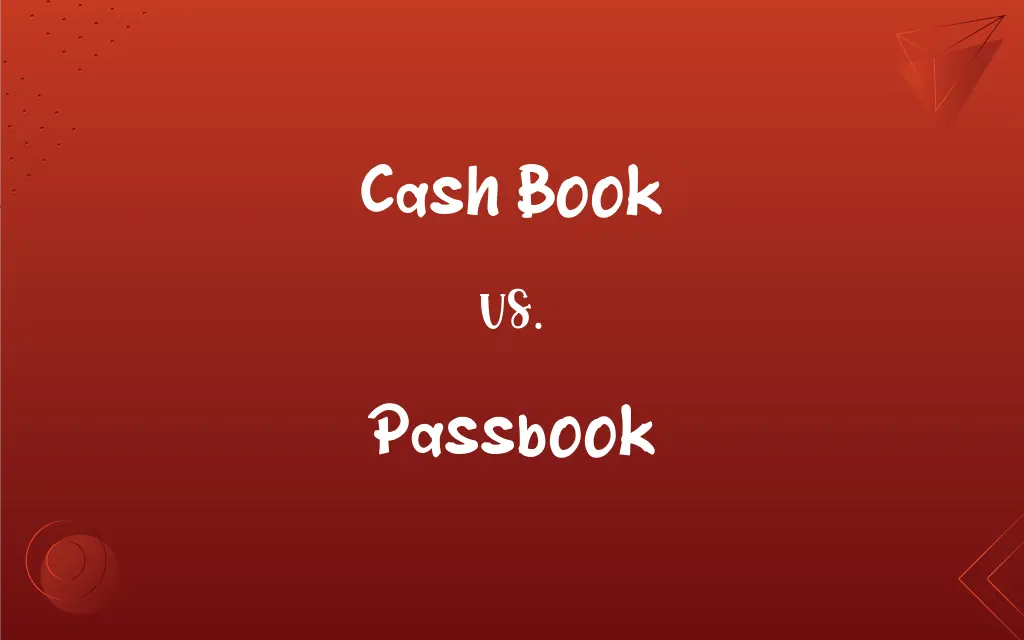Cash Book vs. Passbook: What's the Difference?
Edited by Janet White || By Harlon Moss || Updated on October 22, 2023
A cash book is a financial record maintained by businesses for tracking cash transactions, while a passbook is a bank-issued record for an individual's account transactions.

Key Differences
A cash book is a business tool that meticulously tracks all the cash transactions – both receipts and payments.
On the other hand, a passbook is provided by banks to account holders, detailing all deposits, withdrawals, and balances.
While the cash book serves as both a journal and a ledger in accounting, the passbook strictly remains a record of banking transactions for the account holder's reference.
The cash book plays a vital role in helping businesses ensure that their financial statements are accurate, while a passbook offers transparency to customers about their account status.
Businesses maintain the cash book for internal purposes, while a passbook is a reflection of transactions validated and issued by a bank for its clients.
ADVERTISEMENT
Comparison Chart
Purpose
Tracks business cash transactions (both incoming and outgoing).
Records individual's bank transactions (deposits, withdrawals).
Issued by
Maintained by businesses.
Issued by banks.
Scope
Covers all cash transactions.
Covers all transactions in a specific bank account.
Role in Accounting
Acts as both a journal and a ledger.
Serves as a record for account holder's reference.
Physical Appearance
Typically larger, ledger-style.
Smaller, booklet-style that's easily portable.
ADVERTISEMENT
Cash Book and Passbook Definitions
Cash Book
A comprehensive record of a company's cash inflow and outflow.
The auditor examined the cash book to understand the company's cash position.
Passbook
A physical record of all financial activities in a specific bank account.
I lost my passbook and had to request a new one from the bank.
Cash Book
A book that combines elements of both the journal and ledger in accounting.
The cash book is essential for keeping track of all monetary operations.
Passbook
A booklet reflecting deposits, withdrawals, and balances for a bank account.
Keeping the passbook updated helps in tracking personal finances.
Cash Book
A financial document summarizing cash receipts and payments.
At the end of the month, she reconciled the cash book with the bank statement.
Passbook
A book issued by a bank recording an account holder's transactions.
Every time I make a deposit, the teller updates my passbook.
Cash Book
A record-keeping tool used by businesses to track cash transactions.
The accountant updates the cash book daily to ensure accuracy in financial reporting.
Passbook
A tangible record-keeping tool given by banks to its depositors.
Every time he withdrew money, the bank updated his passbook.
Cash Book
An accounting book that captures every cash-based business transaction.
For accurate financial statements, the cash book needs regular updating.
Passbook
A tool provided by banks for customers to track their account transactions.
She frequently checks her passbook to monitor her spending.
Passbook
See bankbook.
Passbook
A book in which a merchant records credit sales.
FAQs
What is a cash book?
A cash book is a business ledger that records all cash transactions, both incoming and outgoing.
What is a passbook?
A passbook is a booklet issued by a bank that documents an individual's account transactions.
Can individuals maintain a cash book?
Yes, individuals can maintain a cash book for personal financial tracking, but it's more common in business contexts.
Do digital businesses still use a cash book?
Yes, digital businesses may maintain digital versions of a cash book for accounting purposes.
Is it safe to lose a passbook?
Losing a passbook can risk your privacy, and it's essential to report the loss to your bank and take necessary precautions.
What details does a passbook typically contain?
A passbook usually details account transactions, including date, nature (deposit/withdrawal), amount, and balance.
Why is my passbook balance different from my online bank balance?
This discrepancy might arise due to pending transactions, fees, or because the passbook hasn't been updated recently.
Is maintaining a cash book mandatory for businesses?
While not legally mandatory for all, it's a best practice for financial accuracy and is crucial for sizable businesses.
What's the main difference between a cash book and a bank statement?
A cash book records all of a business's cash transactions, while a bank statement lists all transactions of a bank account.
Can the cash book be used for non-cash transactions?
Typically, no. The cash book is specifically designed for cash transactions, while other ledgers/journals track non-cash transactions.
How often should a passbook be updated?
Ideally, a passbook should be updated with every banking transaction, be it withdrawal or deposit.
How does a cash book aid in financial management?
A cash book provides a consolidated record of cash transactions, helping businesses monitor cash flow and ensure financial accuracy.
Is the cash book an official financial statement?
No, the cash book is an internal record-keeping tool, whereas financial statements are formal presentations of financial positions.
Do businesses have passbooks?
Businesses can have passbooks for their bank accounts, just like individuals.
Can I get a digital version of my passbook?
Many banks offer e-passbooks or digital transaction histories through their mobile or online banking platforms.
Are passbooks obsolete in the age of online banking?
While online banking has become prevalent, many banks still offer passbooks, especially in regions where digital banking is less common.
Should a cash book always have a positive balance?
Ideally, yes, but it reflects the actual cash position, which could sometimes be negative based on overdrafts or loans.
Can errors in a cash book affect financial statements?
Absolutely, errors in a cash book can propagate to financial statements, potentially skewing a company's reported financial position.
How do I rectify an error in my passbook?
You should approach your bank with the discrepancy; they'll cross-check and rectify any errors.
Can I access my passbook details online?
Many banks offer online banking services where account holders can view transaction histories, similar to passbook details.
About Author
Written by
Harlon MossHarlon is a seasoned quality moderator and accomplished content writer for Difference Wiki. An alumnus of the prestigious University of California, he earned his degree in Computer Science. Leveraging his academic background, Harlon brings a meticulous and informed perspective to his work, ensuring content accuracy and excellence.
Edited by
Janet WhiteJanet White has been an esteemed writer and blogger for Difference Wiki. Holding a Master's degree in Science and Medical Journalism from the prestigious Boston University, she has consistently demonstrated her expertise and passion for her field. When she's not immersed in her work, Janet relishes her time exercising, delving into a good book, and cherishing moments with friends and family.
































































